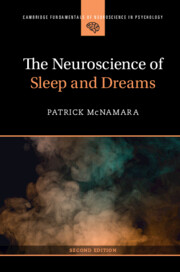Book contents
- The Neuroscience of Sleep and Dreams
- Cambridge Fundamentals of Neuroscience in Psychology
- The Neuroscience of Sleep and Dreams
- Copyright page
- Dedication
- Contents
- Figures
- Tables
- Preface
- Acknowledgments
- Chapter One What Is Sleep?
- Part I Sleep
- Part II Dreams
- Chapter Seven What Are Dreams?
- Chapter Eight Dreams across the Human Lifespan
- Chapter Nine Characteristics of REM and NREM Dreams
- Chapter Ten Dream Varieties
- Chapter Eleven Theories of Dreaming
- References
- Index
- References
Chapter Ten - Dream Varieties
from Part II - Dreams
Published online by Cambridge University Press: 06 April 2023
- The Neuroscience of Sleep and Dreams
- Cambridge Fundamentals of Neuroscience in Psychology
- The Neuroscience of Sleep and Dreams
- Copyright page
- Dedication
- Contents
- Figures
- Tables
- Preface
- Acknowledgments
- Chapter One What Is Sleep?
- Part I Sleep
- Part II Dreams
- Chapter Seven What Are Dreams?
- Chapter Eight Dreams across the Human Lifespan
- Chapter Nine Characteristics of REM and NREM Dreams
- Chapter Ten Dream Varieties
- Chapter Eleven Theories of Dreaming
- References
- Index
- References
Summary
It is not possible to understand dreams unless we become familiar with the whole terrain of dreams. We have discussed ordinary run-of-the-mill dreams that are associated with both REM and NREM sleep states. But there is a very large variety of dream types reported by people. To build an adequate understanding of dreams and a testable theory of dreams, we therefore need to marshal all of the salient facts concerning dreams, and those facts must include the chracteristics of a wide variety of dream types. Scientists who study dreams agree that dreams vary substantially in terms of their content and formal phenomenologic features. For example, children’s dreams are very different from adult’s dreams, and men’s dreams differ substantially from women’s dreams. There are nightmares, “big” or emotionally significant dreams, lucid dreams, shared or mutual dreams, twin dreams (dreams reported by twins), “spiritual” dreams, precognitive or prophetic dreams, visitation dreams (where deceased loved ones appear in a dream), and many other types. Dreams also vary by historical period: Dreams of the ancient Greeks and Romans are different than dreams of people in the Rennaissance period of European history. Dreams also vary by culture: Dreams of people living in traditional socieities are very different from the dreams of modernized peoples. Similarly, dreams of people living in Islamic cultures differ from the dreams of people living in cultures where other religions predominate and so on. All of this should be pretty obvious, but dream variation is an understudied topic in the field of sleep and dream studies. While the variation in dream content and types has been documented, there is little discussion of the theoretical importance of that variation. The fundamental theoretical importance of dream variation, I will argue, is that it suggests that dream function is probably multiple. Dreams do not have only one function. No one theory can account for the huge variation in dream conent. The evident fact that there are multiple dream types is also consistent with the idea that dreams are products of the social brain and function, at least in part, to shape, alter, influence, or manipulate social relationships. Now that is NOT all that dreams do. It is likely that dreams transcend mundane social functions in multiple ways, but we simply do not know enough about these suprarational functions of dreams to comment upon them intelligently. I urge further research on so-called anomalous phenomena and dreams, but I focus here on the available empirical data we have on hand.
- Type
- Chapter
- Information
- The Neuroscience of Sleep and Dreams , pp. 173 - 194Publisher: Cambridge University PressPrint publication year: 2023

